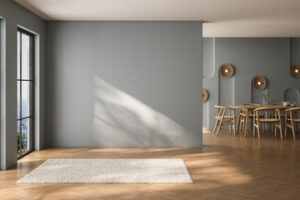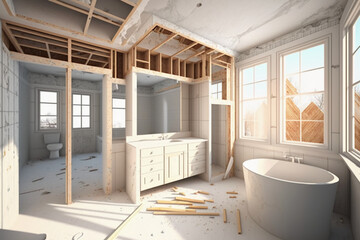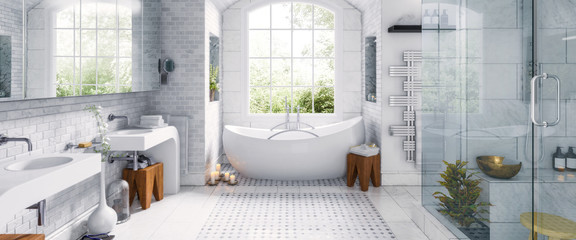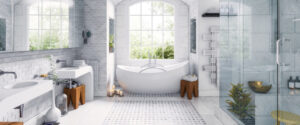Thompson & Boys LLC plays a big role in how rooms look and feel. Homeowners and buyers often choose a style that complements furniture and decoration.
The newest styles of hardwood and tile feature natural looks and decorative patterns. For example, herringbone and chevron parquet patterns add visual interest to any room.

Flooring is the largest surface in any room and is also one of the first things you notice when entering a home. It’s a great way to make a statement and add character to a space without the cost of putting up walls or changing out paint.
Designers are using flooring to express an urban aesthetic. Neutral colors, asymmetrical patterns, and curves characterize this style. Concrete is a popular material used for its unique look, but you can also get the same effect with other materials like wood and stone lookalikes.
Wide-plank hardwood and patterned tile are common flooring concepts that work well with the urban look. For example, a herringbone or chevron pattern can be an eye-catching way to showcase the wood grain of a hickory or walnut floor. A cement-look tile, the Murales collection is a stylish choice in various color variations to create an elegant impression.
A zigzag or offset pattern is another option that works for planks and tiles. The alternating square and rectangular tiles create a fun and unexpected design. That is a great flooring design for adding interest in a small area.
You can also get a similar impact with geometrically patterned laminate or vinyl floors. Many manufacturers offer herringbone or chevron options, but you can also look for other geometric designs to make a more decorative impression. Still, it has hexagonal pieces to add a more modern feel to any living space.
While trends come and go, some neutrals are always in style. Gray tones are the hottest, particularly when combined with warm and cool accents to balance a color palette. You can also find neutrals in various materials, including engineered hardwood, linoleum, and luxury vinyl tile (LVT). Cork is another option that’s making a big impact on designers for its sustainability. It’s also good for high-moisture areas, such as kitchens and bathrooms.
Flooring is one of the most important elements to consider when designing a room, and it can tell people a lot about your aesthetic. For some, this means selecting a traditional and understated style to set the tone for a space, while others may want a bold look on their floors. Whatever your style is, there are plenty of options for incorporating your floor into the design scheme.
Traditional designs often feature an orderly aesthetic, with woods and fabrics that are plush and inviting. These materials and colors can be warm or cool, and many styles are a combination of various periods to create a unique look that feels classic and timeless. These styles aren’t necessarily limited to formal rooms, as they can be used in homes of all sizes and for various purposes.
One way to incorporate a traditional feel into your flooring is by choosing a pattern with an intricate design. This can include tile and plank patterns, such as herringbone and chevron. This pattern adds texture, making a room feel larger or more open. Other pattern options are scrapes and knots, which add an authentic feel to a home and work well with rustic decor. These types of flooring are becoming popular among younger buyers, who are influenced by the traditional design of their parents’ homes.
In addition to pattern, color can also play a role in determining the overall feel of a room. For example, choosing a dark color such as walnut or espresso can make a room feel cozy and intimate, while lighter tones like oak and white can make the space more expansive.
The pattern and color of your flooring can also help create a focal point in a room, which is an important consideration for some spaces. For instance, a herringbone pattern can serve as a striking accent that draws the eye into a room or cleverly mark out areas of interest in a commercial setting.
As the flooring is one of the largest surfaces in a room, it is important to give special attention to the floor design to ensure that the room’s overall look and feel are consistent. While some homeowners may choose to keep their flooring subtle, it’s not uncommon for them to select a bold pattern or texture to set the tone for a space.
The floor is one of the most prominent features in any room, so it’s important to consider creative flooring ideas. While wood is a timeless option that always looks beautiful, there are many other choices as well that can make a statement. Getting creative with color, patterns, and even textures can add a new and interesting feel to your space.
For example, if you want to create a geometric pattern with tile, opt for a chevron or herringbone style that instantly gives your floors a more decorative look. You can also try a hexagonal parquet floor for a unique and modern alternative to a traditional hardwood design.
Another great way to get creative with your floor is by choosing a color that will stand out. While grays continue to be a popular choice, you can also find more muted shades that can play off the colors of other materials in your home, such as earth tones like terra-cotta or greens. Pattern play is also a trend, with checks and different geometric styles making a comeback.
Consider a patterned hardwood if you’re looking for something even more unexpected. While herringbone and chevron designs are classic, you can experiment with other symmetrical arrangements, such as diamonds or hexagons, for a creative, high-end finish to your rooms.
Similarly, if you love having a fun, colorful statement piece but want to commit to something other than an entire flooring renovation, consider painting your floors instead. This may require a professional to complete, but it can be an affordable way to bring your personal touch to your rooms.
Another great way to get creative with your floor, but not as cost-effective, is to use a wood inlay. This requires a skilled hand to create and install but can add jaw-dropping results. Compasses, stars, and other complex geometric shapes are common inlays, but you can also have your family motto or crest inlaid in the wood for an even more unique design. You can also try this with concrete if you’re willing to take on the labor-intensive project.
When you have two different flooring types in the same room, making a good transition between them is important. This will help to create an even look and feel for the space. It can also help hide seams that appear when the materials expand or contract differently. There are many ways to do this, but one more interesting and unique method is using a special flooring transition called an “edge strip.”
This can be made of the same material as either floor or a contrasting color and can be used to frame the area where the two fabrics meet. The edge strip can be cut into different shapes, or it can be made of an eye-catching decorative material that adds an extra design element to the room. This is a great option for areas where a straight line would be too boring or for rooms with an unusual shape that does not allow for the installation of long, continuous floorboards.
In the past, a typical solution was to have the different floor materials meet without using a transition strip. However, this is only sometimes an option and can be a safety hazard. Having a hard line between the floors could be more aesthetically pleasing. Instead, a transition strip can provide an even smoother, safer finish to walk on.
There are several options for creating a flooring transition that is both functional and attractive. For example, a wide mosaic tile strip can be used as a detailed transition border between different flooring materials. It adds an eye-catching touch and a pop of color, making the transition between floors more visually appealing. Other options include using thin metal strips for functional and aesthetic purposes. These can be positioned at the same level as the flooring or placed on top of the tiles to provide a more finished appearance and protect them from damage.


 Cost
Cost
 Cost
Cost